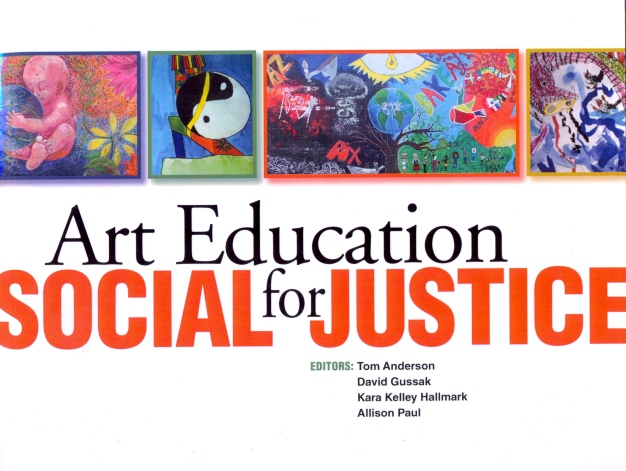Academic Journals:
Carpenter, B. S. (2014). Leading through giving and collaborating: Considerations for socially engaged arts-based practice and collaborative leadership, Visual Inquiry: Learning & Teaching Art 3(3), 309–322. This article considers how arts-based and other practices inform creative leadership capacities. This consideration is grounded primarily in a reflection on previous work of artists and their colleagues on the production, advocacy and education of colloidal silver-enhanced ceramic water filters as a response to the global water crisis. Central to this reflection is consideration of how this work informs creative leadership capacities through theoretical lenses of collaborative leadership, socially engaged practice and art practice as giving. Ultimately, the intention is to suggest that creative leadership as praxis takes form through cultural production beyond object-making, favoring the facilitation of meaningful relationships among people, ideas and contexts, as they arise from collaboration and social engagement. [PUBLICATION ABSTRACT].
Carpenter, B. S., Cornelius, A., & Sherow, E. (2010). Water: Contemporary art and social issues. Art Education, 63(6), 25-32. (This Instructional Resource is based on our current efforts as part of an interdisciplinary project where artists, community members, engineers, social activists, and educators are working together to make positive change in people’s lives. Water, as a subject, symbol, and live-sustaining substance, is the focus of our work and the interdisciplinary curriculum it has inspired. We have found that interdisciplinary approaches in partnership with inspiration from real life social issues can provide a central point of focus for a series of meaningful learning experiences that relate to current interests in global and green movements (Anderson, 2000; Simon, 2006), sustainability (Chilman, 2004), and contemporary social projects. [PUBLICATION ABSTRACT].
Lantagne D, Klarman M, Mayer A, Preston K, Napotnik J, Jellison K. Effect of production variables on microbiological removal in locally-produced ceramic filters for household water treatment.. Int J Environ Health Res. 2010 Jun;20(3):171-87. Diarrhoeal diseases cause an estimated 1.87 million child deaths per year. Point-of-use filtration using locally made ceramic filters improves microbiological quality of stored drinking water and prevents diarrhoeal disease. Scaling-up ceramic filtration is inhibited by lack of universal quality control standards. We investigated filter production variables to determine their affect on microbiological removal during 5-6 weeks of simulated normal use. Decreases in the clay:sawdust ratio and changes in the burnable decreased effectiveness of the filter. Method of silver application and shape of filter did not impact filter effectiveness. A maximum flow rate of 1.7 l(-hr) was established as a potential quality control measure for one particular filter to ensure 99% (2- log(10)) removal of total coliforms. Further research is indicated to determine additional production variables associated with filter effectiveness and develop standardized filter production procedures prior to scaling-up. [Publication Abstract]
Mintz E, Bartram J, Lochery P, Wegelin M. Not just a drop in the bucket: expanding access to point-of-use water treatment systems. Am J Public Health. 2001 Oct;91(10). Since 1990, the number of people without access to safe water sources has remained constant at approximately 1.1 billion, of whom approximately 2.2 million die of waterborne disease each year. In developing countries, population growth and migrations strain existing water and sanitary infrastructure and complicate planning and construction of new infrastructure. Providing safe water for all is a long-term goal; however, relying only on time- and resource-intensive centralized solutions such as piped, treated water will leave hundreds of millions of people without safe water far into the future. Self-sustaining, decentralized approaches to making drinking water safe, including point-of-use chemical and solar disinfection, safe water storage, and behavioral change, have been widely field-tested. These options target the most affected, enhance health, contribute to development and productivity, and merit far greater priority for rapid implementation. [Publication Abstract]
Books/Books Chapters
Wick, W. (1997). A drop of water: A book of science and wonder. New York: Scholastic Press. Describes the origins, characteristics, and uses of water (Publication Abstract).

Taylor, P. G., & Carpenter, B. S. (2013). Social Justice Art and Pedagogy: Taking Action (Because it’s the Right Thing to Do). In Ballengee-Morris, C., and Tavin, K. (Eds). Stand(ing) up for change, pp. 121-127. National Art Education Association, Reston, VA.
Carpenter, B. S., & Muñoz, M. (2012). In search of environmental justice and clean water: Encouraging artistic and collaborative responses through the possibilities of sustainable appropriate technologies. In Hoctritt, L., Quinn, T., & Ploof, J. (Eds.), Art and Social Justice Education: Culture as Commons, pp. 124-130. New York: Routledge.
Carpenter, B. S., Muñoz, O., Muñoz, M., Arcak, C., Cornelius, A., & Boulanger, B. (2011). Re/searching for clean water: Artists, community workers and engineers in partnership for positive community change. In Cheryl McLean (Ed.), Creative Arts in Research for Community and Cultural Change, (pp. 41-64). Calgary: Detselig/Temeron Press.
 Carpenter, B. S., Taylor, P. G., & Cho, M. (2010). Making a (visual/visible) difference because people matter: Responsible artists and artistic responses to community. In T. Anderson, D. Gussak, K. K. Hallmark, & A. Paul. (Eds.), Art education working for social justice (pp. 60-66). Reston, VA: National Art Education Association.
Carpenter, B. S., Taylor, P. G., & Cho, M. (2010). Making a (visual/visible) difference because people matter: Responsible artists and artistic responses to community. In T. Anderson, D. Gussak, K. K. Hallmark, & A. Paul. (Eds.), Art education working for social justice (pp. 60-66). Reston, VA: National Art Education Association.
Carpenter, B. S. (2010). Embodied social justice: Water filter workshops as public pedagogy. In J. Sandlin, B. Schultz, & J. Burdick (Eds.), Handbook of public pedagogy: Education and learning beyond schooling (pp. 337-340). New York: Routledge.
Hoyt, M. W., & Carpenter, B. S. (2008). Navigating water/democracy: Thirst, irrigate, drown, cleanse. In A. Fidyk, J. Wallin, & K. den Heyer (Eds), Democratizing educational experience: Envisioning, embodying, enacting (pp. 61-82). Troy, NY: Educators International Press.
Carpenter, B. S. (2003). Making meaning meaningful: Interpreting contemporary ceramics with “at risk” high school students. In S. Klein (Ed.). Teaching art in context: Case studies for preservice art education (pp. 41-45). Reston, VA: National Art Education Association.
Others







